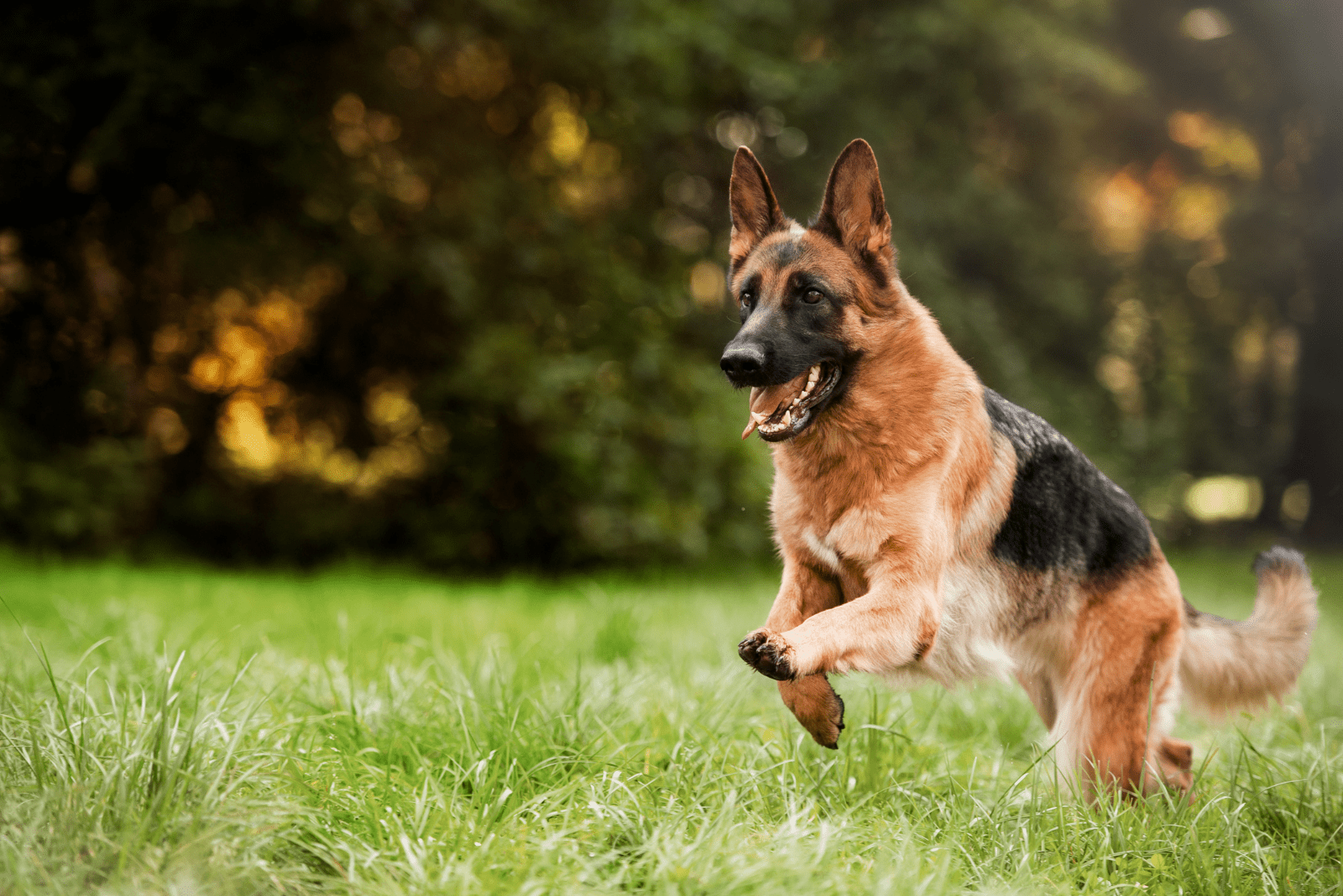They are one of the most recognizable dog breeds in the world, and yet there are 7 different types of German Shepherds or GSDs. Why is that? Well, the answer mainly lies in the confirmation of their body, back legs length, etc. But German Shepherd dogs can also be separated according to their coat color. The one we all know is the so-called red and black German Shepherd. But do you know there are 13 coat color types of German Shepherds?
They are in the movies, in our neighbor’s backyard, they are everywhere… Let’s learn to differentiate the 7 types of German Shepherds and learn a bit more about their amazing colors.
7 Types Of German Shepherds
This breed is very old and German Shepherds have been helping people all around the world with all kinds of jobs. People loved them back then and we love them now, so we took the liberty of experimenting with their coat colors and physical appearance.
That’s how, today, we have 7 types of German Shepherds. There are five different Lines of German Shepherds, one long-haired GSD, and the cutest of them all — the Miniature German Shepherd.
The basic differentiation is based on whether the German Shepherd is used for shows or for work. From there, we can separate three different working lines and two show lines, but the show lines can be divided into even smaller groups (or clubs). We will talk about them all, but first… what did the original German Shepherd dog look like?
As we’ve mentioned, the Show lines and Working lines can be separated into smaller categories, too. The reasons for so many lines are subjective opinions and a little bit of politics.
After World War II ended, there were three separate working lines of GSD:
• West German Working Line
• East German Working Line or DDR
• Czech Working Line (former Czechoslovakia)
In the beginning, politics played a great part in making West German and East German Working Lines. After WWII ended, Germany was divided into West Germany and East Germany. They had different views on many things, including how to breed a German Shepherd dog.
Because of these differences, we have more than three types of German Shepherd dogs. They are divided into three Working lines and two Show lines. As for the Show lines, there is no politics involved, but a lot of different opinions regarding what is considered beautiful and worthy of the dog show competitions.
1. West German Working Line
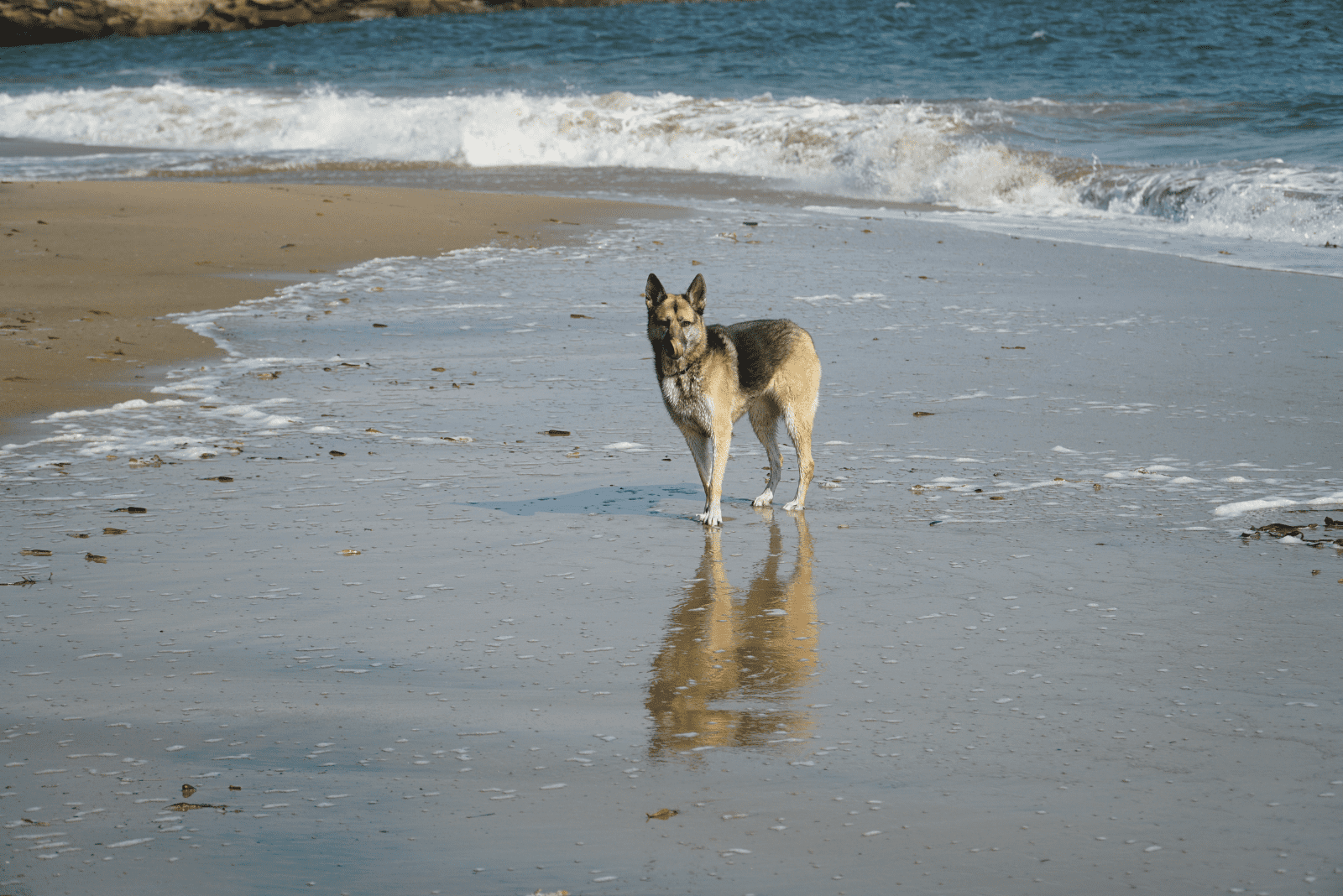
The German Shepherd was originally bred as a working dog. They used this dog breed to help with herding sheep and other animals on European farms. The West German working line is the one that is the closest to the appearance of the original German Shepherd dog.
The origin of today’s West German working line with today’s breed standards started with Beowulf and Schwaben — two German Shepherd dogs bred by Max von Stephanitz. They are the “grandads” of today’s German Shepherds.
Max von Stephaniz was the one who set the guidelines for the German Shepherd breed, and the first president of the German Shepherd Association or the Verein für Deutsche Schäferhunde in German.
Looks And Temperament
The West German working line has a more sloped back. Their whole body seems closer to the ground, as if in a permanent prowl. They are more athletic than other working lines, with good bone support. They also come in rich colors, and the usual coat color variations are Black and tan, Black and red, bi-color, and almost black.
The West German Working line has a calm temperament but a strong prey drive and excellent working ability. They are very energetic, and they will need a lot of mental and physical stimulation to keep them happy and healthy.
If you are looking for a family dog rather than a dog that has a strong working drive, a German Shepherd from the West German Working line might not be the best choice for you. These dogs were bred to work and to be active, and you will have to make sure they have enough daily exercise.
We can all understand better how energetic, strong-willed, and marvelous these dogs are when we take a look at all the jobs they do. The West German Working line of German Shepherd dogs are most used as:
• Police dogs (drug-sniffing dogs)
• Military dogs (bomb detecting, scouting)
• Search and rescue (disaster response team)
• Service dogs (guide dogs, seizure alert dogs, etc.)
Are They Good Family Pets?
Of course, they are amazing family pets, too. They will need proper socialization and proper dog training, if possible, with a professional dog trainer. These steps are necessary for the dog’s proper behavior with other dogs and animals. As for the family, the German Shepherd is one of the best family dogs. Just remember to give them enough of physical stimulation — running, hiking, and playing in the yard.
Even though this type of German Shepherds is a working type, they still love and want a lot of affection. They are our pets, and I am sure — best friends too, so don’t forget to give them a lot of love, as well. Just because they have imposing appearances, doesn’t mean they don’t enjoy or need a good hug or doggy kiss.
In general, all Working Line German Shepherds are best suited to owners who already have some experience with dogs. This is because of their strong working and prey drive.
2. East German Working Line (DDR)
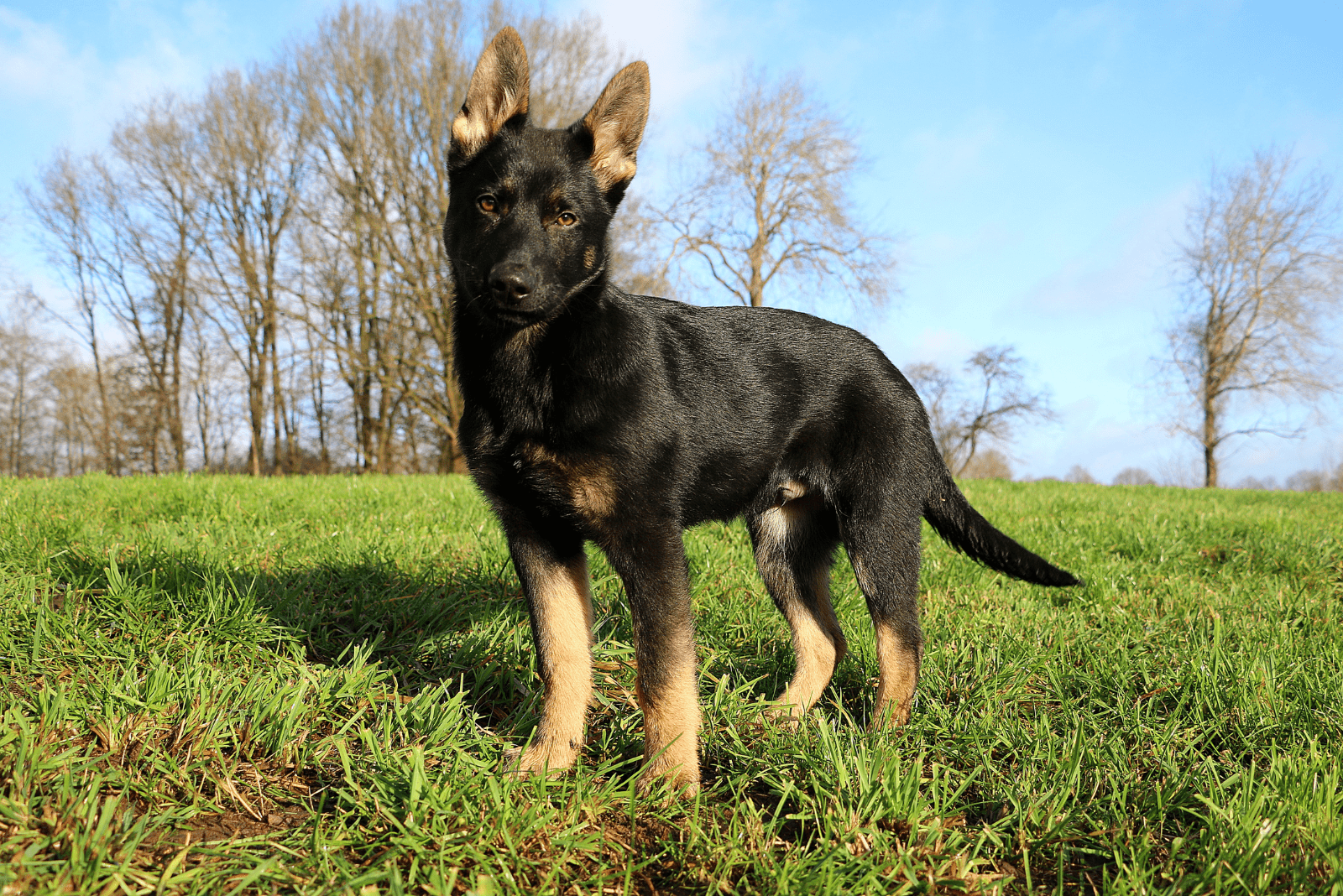
This type of German Shepherd is truly all about work. As we’ve mentioned before, the two biggest lines — the West and East lines, were made after the end of World War II. The abbreviation DDR stands for the Deutsches Demokratische Republik — the official name of East Germany.
The East German Working line of German Shepherd dogs was bred to work long hours in harsh weather. They were mostly used for patrolling the borders with the military, but the East side used them as Police and Rescue dogs, too. The biggest difference between these two bloodlines, the West and the East, is in the size.
Looks and Temperament
The East German Working line German Shepherd has a bigger head, bigger body in general, with massive bones and bigger muscles. They did everything to make sure their line of German Shepherds was more endurable and more powerful than the West German line of dogs.
The breeders of this line went as far as to not breed any dogs that showed signs of weak temperament or signs of genetic diseases. The result was a dog with an extremely high working drive, a loyal temperament, and a body that has a less sloped back and longer back legs.
As for the color, they did not go for rich colors as much as for the effectiveness of the colors. So, they preferred the Sable coat color or similar less noticeable colors that could be very useful in the dark or when prowling.
Unfortunately, after the fall of the Berlin Wall in 1989, a lot of dogs had nowhere to go, because they were not needed anymore. There were no borders to patrol. So, they were put down or abandoned, and the lucky ones were given to those who needed guard dogs.
Are They Good Family Pets?
But today there are breeding programs that keep this wonderful working line alive. And they make sure they have the best treatment! The results today are excellent working dogs that are great with families too!
They are so loyal that you can be sure they will do anything to protect your children, no matter how young they are. Of course, they will still need socialization at an early age.
But, in general, DDR German Shepherd will be protective and gentle with your children, almost like a dog babysitter whom you can trust. They are also patient and sturdy, so they can take an occasional pull or push from a child during playtime.
3. Czech Working Lines
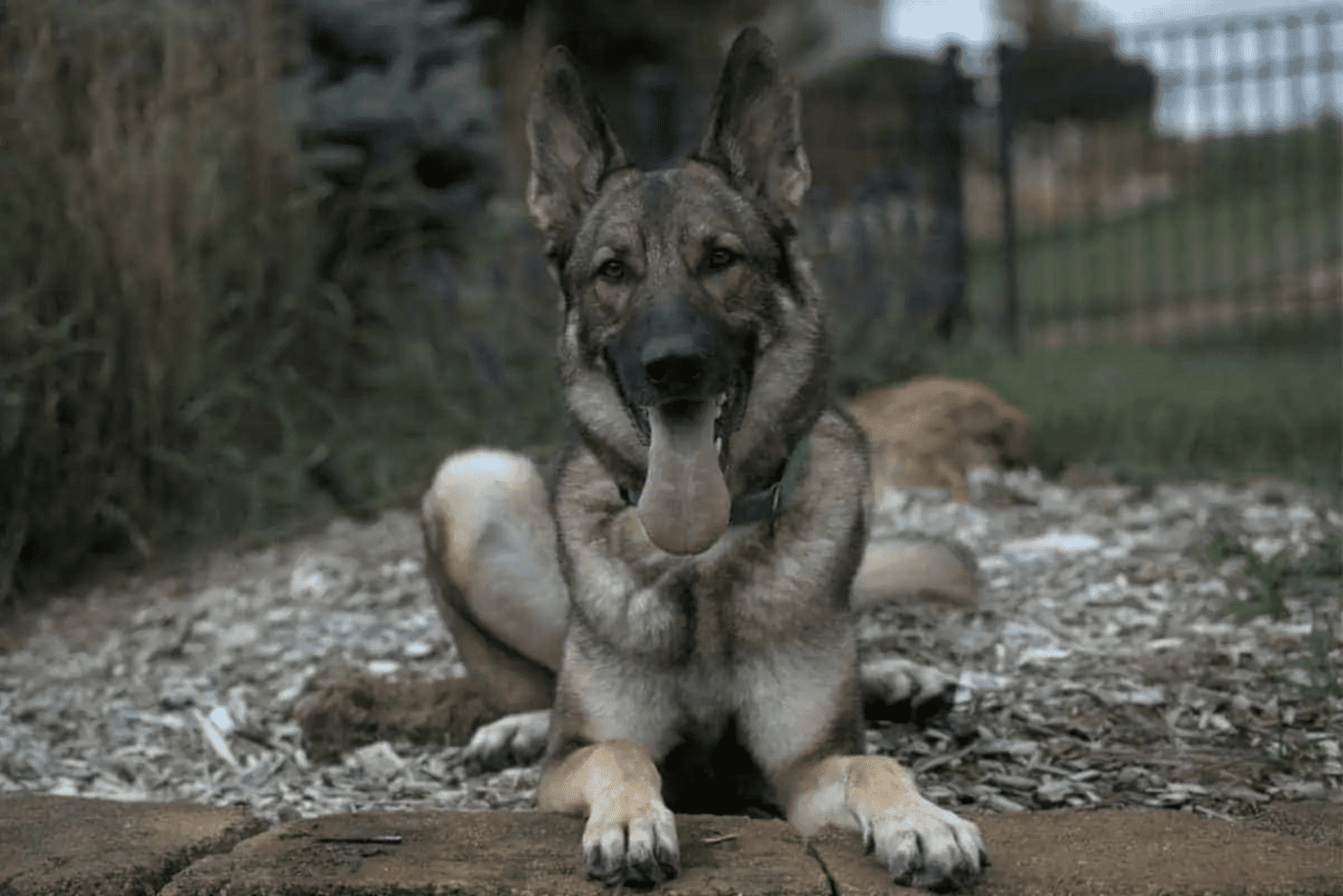
The Czech Working line of German Shepherd dogs originated in Czechoslovakia, a former republic that bordered East Germany. They needed dogs that would be excellent at patrolling the border and easy to train, with a high working drive. So, they “borrowed” some of the East Germany line GSDs and made their own type of German Shepherd.
The Czech Working line German Shepherd is the biggest of all types of German Shepherds. They also have the least sloping backs, and they are generally the most robust type of GSD. They are also called Czech German Shepherds.
The usual coat colors they come in are rich bi-colors, with just a little bit of lighter color on the lower parts of the body. The other coat color variation is Sable with darker tones. Of course, lighter variations are accepted as well.
This type of German Shepherd is very smart. They will easily learn all tricks and rules, no matter if it’s guarding the yard or jumping over a hurdle. Even though they sound harsher than other Working Lines, they are still amazing family pets.
All dogs need proper early socialization during their puppyhood. So, the Czech Working line GSD will need proper socialization too. Through socialization, your German Shepherd puppy will learn how to behave in presence of other dogs, animals, strangers, and young children.
4. West German Show Line
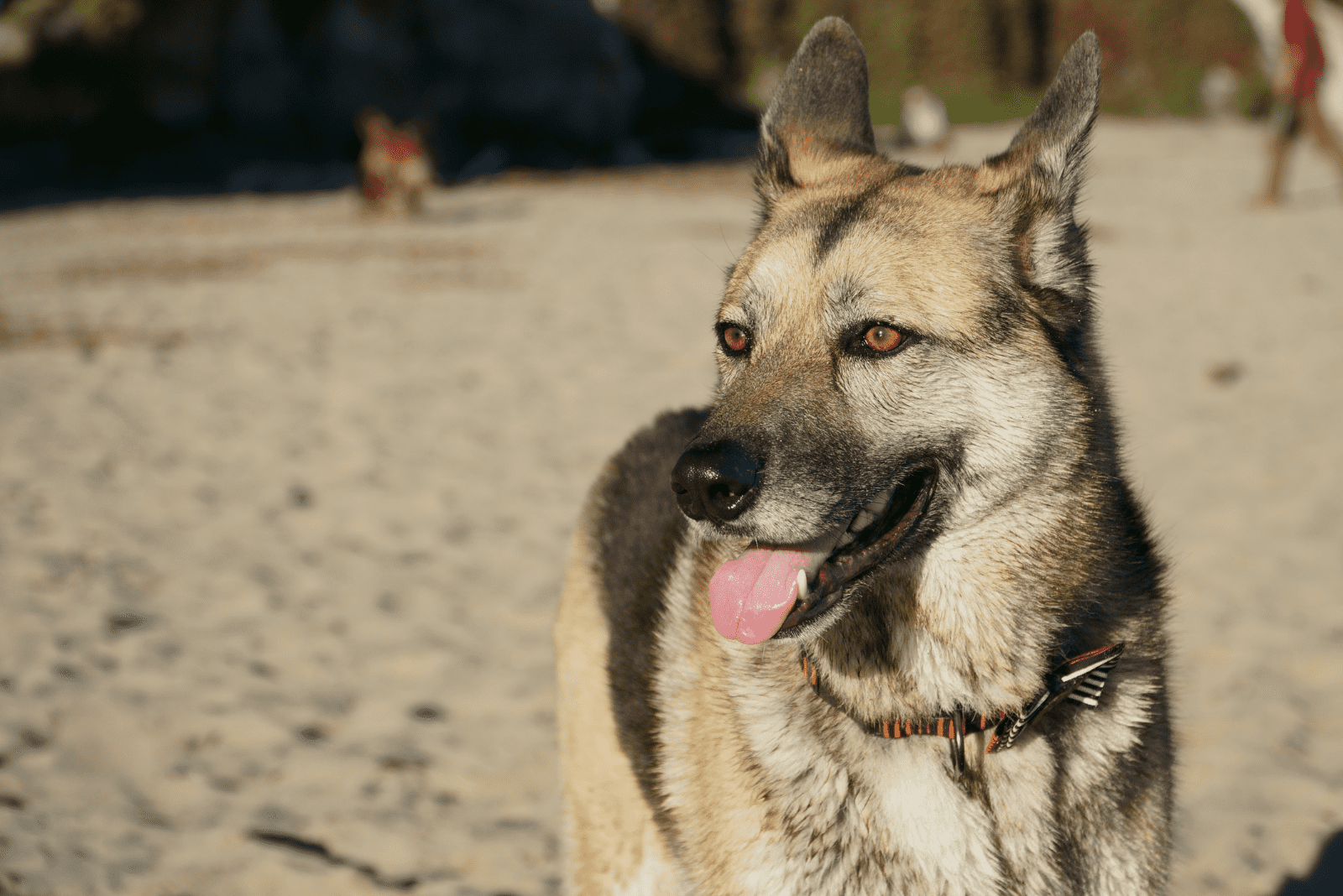
The West German Show line dogs are also called European Show line dogs. These German Shepherd dogs are smaller than their Working Line cousins. They also have a more sloped back, shorter legs, and a generally smaller appearance compared to all working lines.
But, compared to the American Show Line German Shepherds, they are much stockier and strong looking, with bigger heads and muscles.
When it comes to West Show German Shepherds, there is one coat color that is preferred: rich black and tan. Other coat color variations are accepted, but not white! In general, European Show line dogs should have more vivid colors, with a more distinct line between the black color and the other lighter colors.
But, color is not the most important trait of the German Shepherd dogs from the West German Show line. It is their temperament.
They look for dogs that have a unique temperament:
• trainable
• intelligent
• agile
• calm
In essence, they look for a German Shepherd that has the agility of the Working GSD but the looks and the temperament of a show GSD. And, because of these traits — all Show Line German Shepherds make wonderful pets!
5. American Show Line
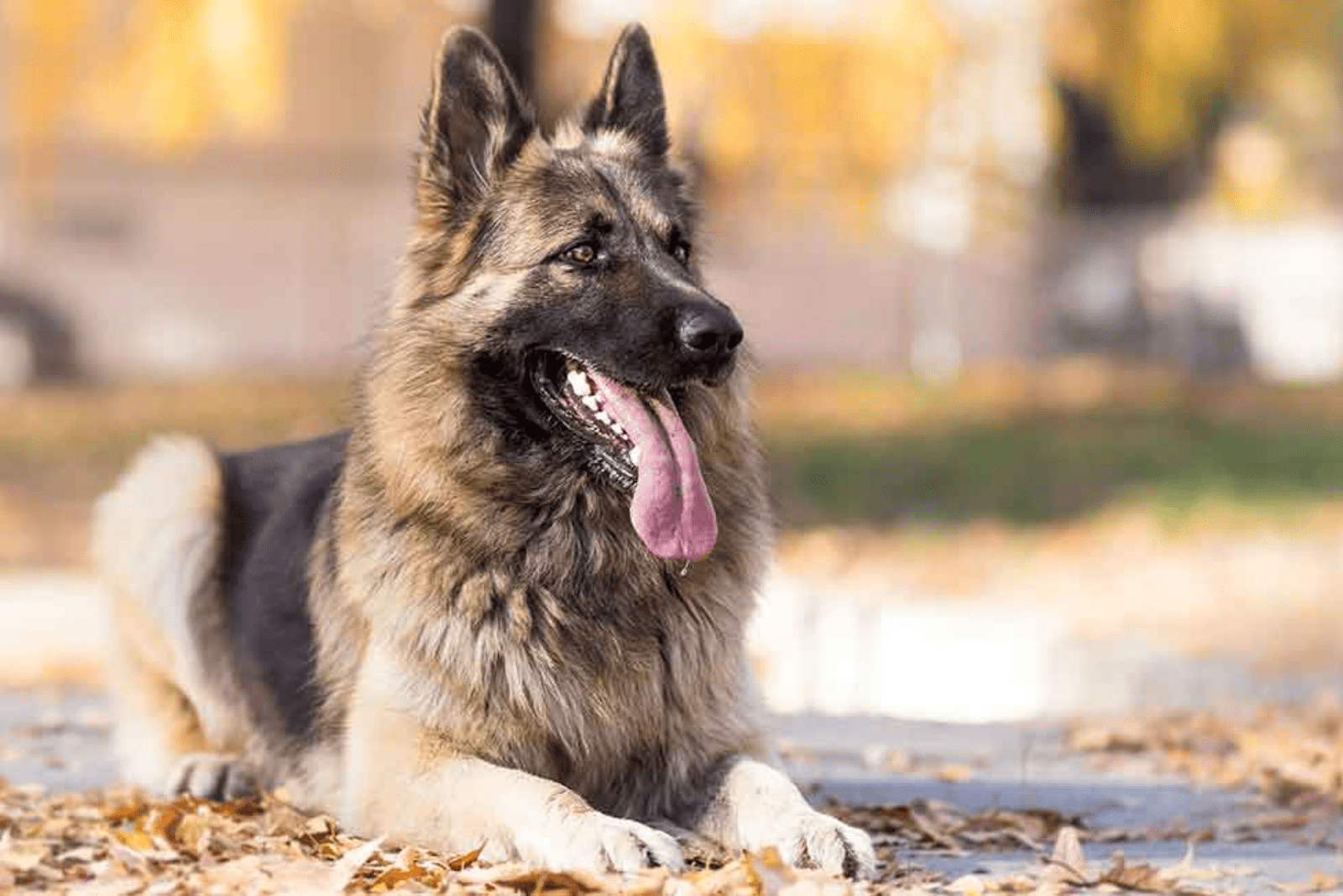
The German Shepherd dog breed became show-exposed in the States in 1907. But their true popularity began after World War II when the standard for the Show Line German Shepherd was developed.
This type of German Shepherd has the most sloped backs of all GSDs in both Working and Show Lines. They also have a bigger variety of coat colors, even the white coat color. Although the AKC now recognizes the white coat color of the German Shepherd, that wasn’t the case a few years back.
The AKC was strongly against the white color, and they considered blue and liver as serious faults as well. But, today, all of these coat color variations are not only accepted but recognized as standard colors by the American Kennel Club and CKC (Canadian Kennel Club).
According to the AKC (American Kennel Club) standards these dogs must have:
• longer muscular body
• long muzzle
• pointy ears
• bushy tail
• longer forequarters
• shorter hindquarters
This type of German Shepherd is calm and appears tamer. They are well-adjusted to living in a family with or without young children. Actually, the American Show Line German Shepherd is one of the most popular family dogs.
There are some who believe that German Shepherds are aggressive, but that highly depends on their proper training and proper early socialization. Every dog can exhibit some form of aggressive behavior, no matter the size or breed. How we treat dogs from their puppy years and how we teach them to behave in front of other people, other dogs, and other animals, is of great importance when they grow up.
As for the temperament difference between female and male German Shepherds, there are some that should be considered when considering buying a Show Line GSD. The most important one, when it comes to bringing a GSD to a home with children, is that female German Shepherds bond easier with children and play less “rough” than male GSDs.
The American Show Line German Shepherd dog is a type of German Shepherds that can go well with other animals too. If you were wondering specifically if German Shepherds go well with cats, I’ll give you a quick answer: they can go well. But it depends on some factors in which age plays the biggest role. If you introduce a puppy GSD to a kitten, then there is no doubt they will become best friends as they grow together.
6. Long Haired German Shepherd
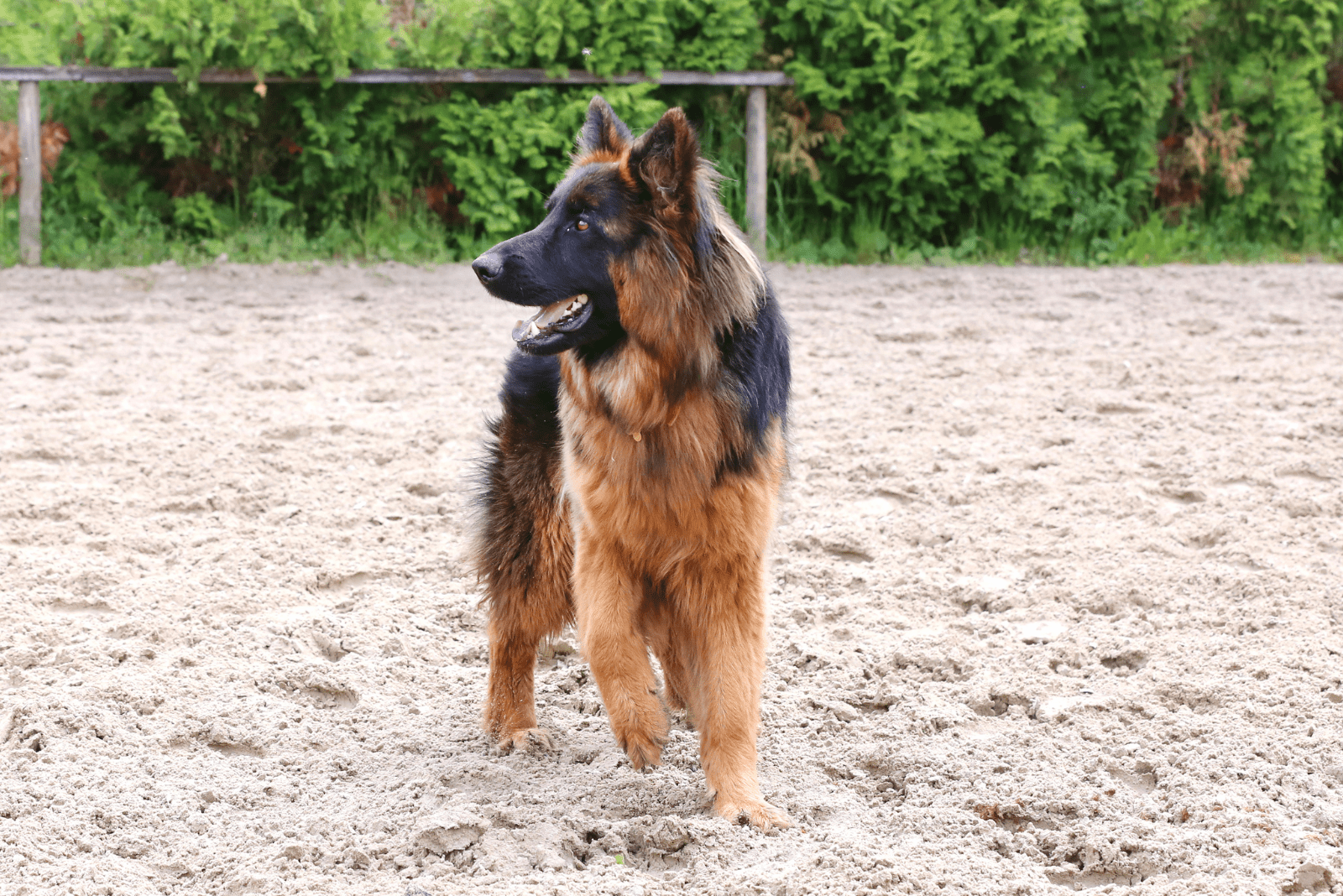
This is another variation or type of German Shepherd dog. As their name suggests, they have a long straight coat.
In the past, the long haired Shepherd Dogs were disqualified from shows according to the AKC standards. But a lot has changed since then, and today the AKC as well as the CKC recognizes both German Shepherd dogs as purebred GSDs.
And they should! The Long haired German Shepherd is the same beautiful and smart doggo as the short haired version. Because of their long coat, which is already double, they can appear bigger than the original medium-haired or short-haired German Shepherd. But, in truth, the height and the weight of both German Shepherd types are the same.
And, if you were asking the question of ‘do German Shepherds shed less or more than their Long haired cousins?’, well the answer is — neither. Both types of German Shepherd dogs shed equally, and that is a lot.
But they don’t require a special type of grooming technique. All kinds of GSDs require a quick brushing every day or two, with just an occasional bath. There are different brushes for German Shepherds that you can choose depending on the coat length of your GSD. And if you brush your dog’s fur to keep it shiny and healthy, it is only fair that you choose a special collar for German Shepherds, worthy of their beautiful looks!
7. Miniature German Shepherd
Although this is not a purebred German Shepherd dog, it deserves to be mentioned as a GSD type because of its cuteness and special place in people’s hearts all around the world.
The Miniature German Shepherd is a designer dog, which means that the breeders specifically bred a German Shepherd with another purebred dog to produce a dog that has the best traits of both dog parents.
The most common purebred dog used in making the Miniature GSD is a Standard Poodle or a Border Collie. But other breeds can be used too, like Huskies, Golden Retrievers, Corgis, etc.
The temperament of the Miniature German Shepherd is not diminished because of its size! On the contrary, this dog crossbreed has more to offer because of the two purebred dog parents in its gene pool. So, when you mix an intelligent German Shepherd dog with an intelligent Poodle or Border Collie the results are brilliant — a very intelligent GSD with the best traits of both breeds.
Loyal, friendly, intelligent, trainable, and affectionate! It is no wonder that breeders around the world started mixing these dog breeds to make the amazing Miniature German Shepherd.
Types of German Shepherd According to Coat Colors
According to size and temperament, there are 7 types of German Shepherds and we have talked about all of them. But that is not the end! The German Shepherds can be differentiated by coat color, as well. As a matter of fact, there are 13 different types of German Shepherd according to their coat color.
1. Black and Red
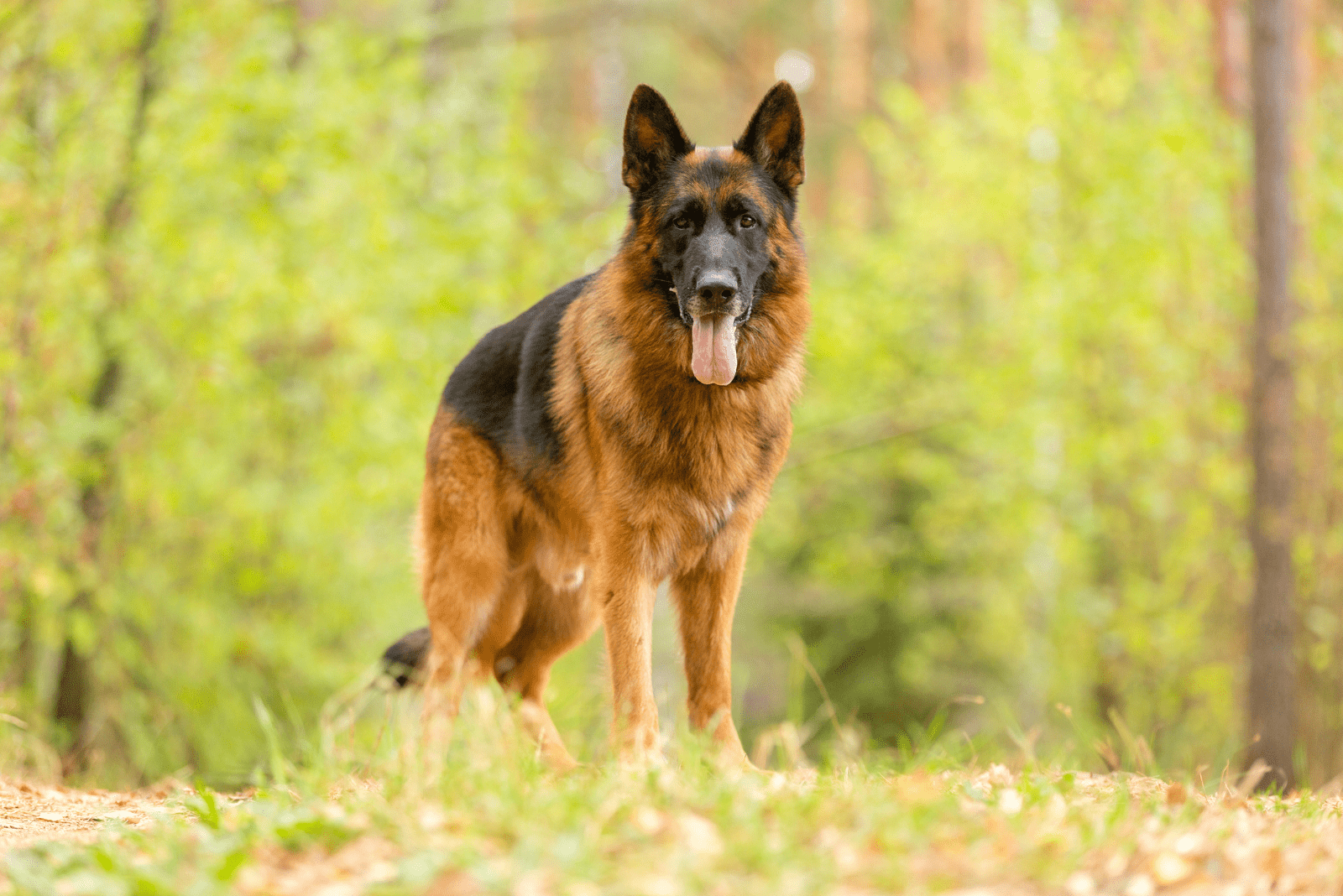
The red and black German Shepherd is the one we all know. It is the most recognizable of all GSDs. The base color of this wonderful dog is dark tan or red with characteristically black markings.
They have a black “saddle” covering the back and going onto the tail. They also have black masks on their faces — a black snout, ears, and a bit of black coloring around the eyes. This mask can vary from dog to dog, but in most cases the snout is black. The lower part of the tail is red in color, as well as the rest of the body.
The red and black German Shepherd can be also called the Red German Shepherd and they are mostly used in dog Shows, especially European shows, rather than as working dogs.
But that doesn’t mean there are no red and black working dogs. Both lines of German Shepherds can come in all 13 types of coat colors.
2. Black and Tan
The tan and black German Shepherd (or black and tan) is number two when it comes to worldwide fame. In essence, the tan and black German Shepherds have the same black patterns as the Red GSDs, but the part that is red is tan. The tan color is pale red or a darker sand color. It is less desirable as a show dog, especially for show lines in Germany. The reason the red German Shepherd is more desirable, and not the tan and black German Shepherd, is because the show standards require the dog to be of more expressive and darker colors. These colors are just simply preferred.
Just like the Red GSD, the Tan German Shepherd has a black snout, a black saddle on the back, and the upper part of the bushy tail is black.
3. Red Sable
The Red Sable German Shepherd is a Red German Shepherd with more black hair than usual. These are interesting-looking dogs. They still have the characteristic German Shepherd black mask and black saddle, but the saddle part spreads down through the whole body, reaching the lower parts of the torso.
The legs can be black too as well as the whole head. But this is not a solid black color, like in bi-color German Shepherds. The black is constantly intertwined with lighter hairs — red or tan color.
Generally, all sable dog breeds are considered black dogs with lighter hair roots. This is the rule for the Red Sable German Shepherd, as well.
4. Silver
All types of German Shepherd dogs are beautiful, but the Silver German Shepherd is one of the most beautiful GSDs. No matter if it’s a show dog, a working dog, or a family dog — this is a beautiful type of German Shepherd.
They are very rare and breeders around the world know this, so they do not sell their German Shepherd puppies of this coat color for less than $3,000.
What is the deal? Well, combine the black markings with silver and you get the Silver Sable German Shepherd. In essence, they have silver hair roots all through their body, permeating the black color everywhere, especially on the lower body, legs, and head.
5. Gold Sable
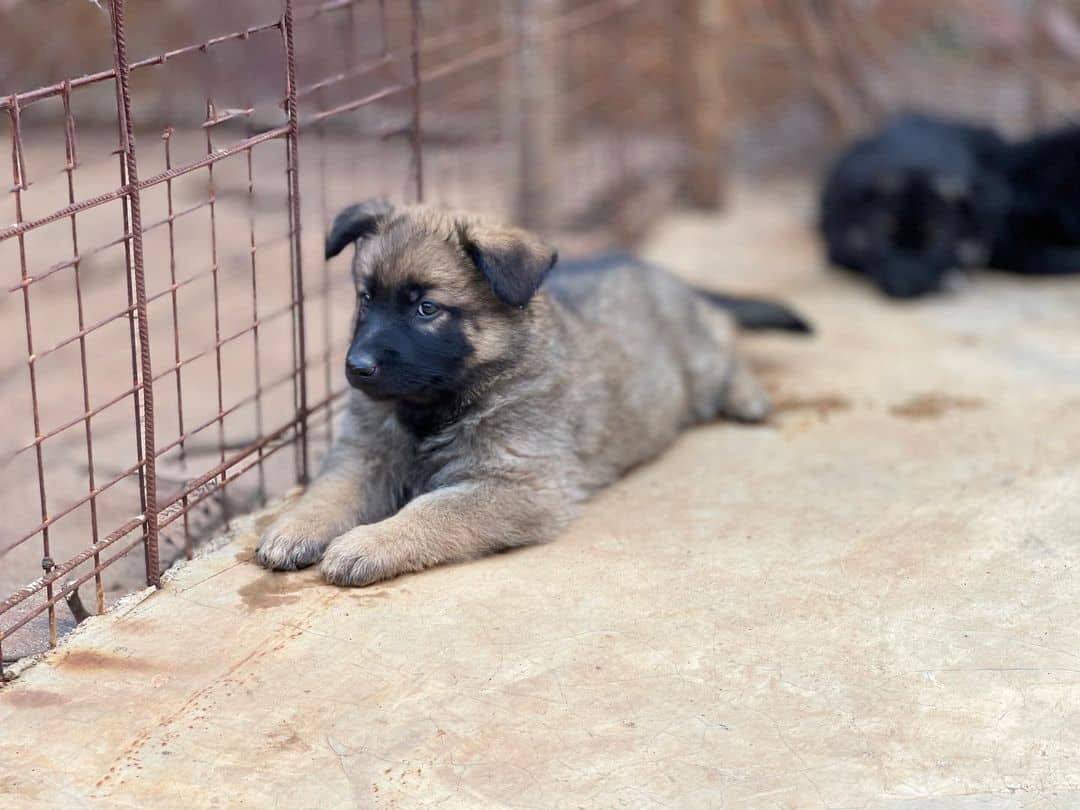
Photo from: @pet.services.263
But, if you’re not used to this type of German Shepherd, they can look like Belgian Shepherds (Malinois) because of the golden color of their fur with occasional black markings on the back and on the muzzle.
We say they can look like Malinois, but in truth, Belgian Shepherds can have various coat color variations of which fawn, mahogany, and red are the most common.
6. Solid White German Shepherd
This type of German Shepherd has all the traits of a normal GSD even though it had some problems in the past. The problems came from the Nazis, show runners, and some people who thought they were not good shepherd dogs because they are white.
The white German Shepherd is just like an ordinary German Shepherd but solid white in color. They are not albinos, and no — they will not cause the “fading” of the coat color in future generations.
A lot of doubts were laid on this amazing and beautiful-looking type of GSD and for no reason! They are actually great as shepherd dogs because they blend in with the flock of sheep. Blending enables them to surprise the wolves or other predators looking to snatch a sheep or two. And the reason for the Nazi’s grudge against these beautiful dogs was, well… because they were Nazis. We shouldn’t listen to them at all.
7. Solid Black German Shepherd
Black German Shepherd or Solid Black GSD is another variation of this breed with beautiful characteristics. It is believed that these dogs were bred unintentionally or by accident, but because of their beauty — people started breeding them on purpose.
A black German Shepherd is a purebred dog that has a solid black coat color. Even though the solid black color is not the first thing that comes to your mind when you think of the German Shepherd dog breed, this coat color variation of the GSD is accepted by the American Kennel Club.
Once again, the Belgian Malinois in solid black coat color variation can look like a Black German Shepherd. But truth be told, there are other dogs that look like German Shepherds out there. And it doesn’t matter, because every dog is unique and beautiful in its own way.
8. Solid Liver German Shepherd
They are beautiful-looking German Shepherd dogs that come in solid reddish-brown coat color variations that can resemble an Isabella color.
The adult Solid Liver GSD has brown-reddish color all over the body, equally, without black saddle markings on the back.
This color is caused by a dilution of pigment which turns the black color into brown “liver” color. Liver German Shepherds have brown nose leather, and they can come in other types, not just solid liver. One of them is the tan and liver coat color variation. In that case, the dog has a liver saddle, a liver mask on the face covering a muzzle, ears, and patches around the eyes, as well as the tail. The rest of the body is a tan color.
9. Steel Blue German Shepherd
The Steel Blue German Shepherd or simply Blue German Shepherd is a dog with a striking appearance. They are the most wolf-looking GSDs out there, especially if they don’t have any other colors in their beautiful coats.
The Blue German Shepherd is just like an ordinary-looking GSD, but the difference is in the diluted gene, something that happens in the Liver GSDs too. This time the diluted gene turns the black color into the steel blue color that can come in darker or lighter shades.
The most important difference is that Steel Blue German Shepherds don’t have a black saddle on the back or the famous German Shepherd’s black mask on the face. They are solid deep blue all over the body, and they have brown to dark-brown eyes and gray nose leather.
10. Albino German Shepherd
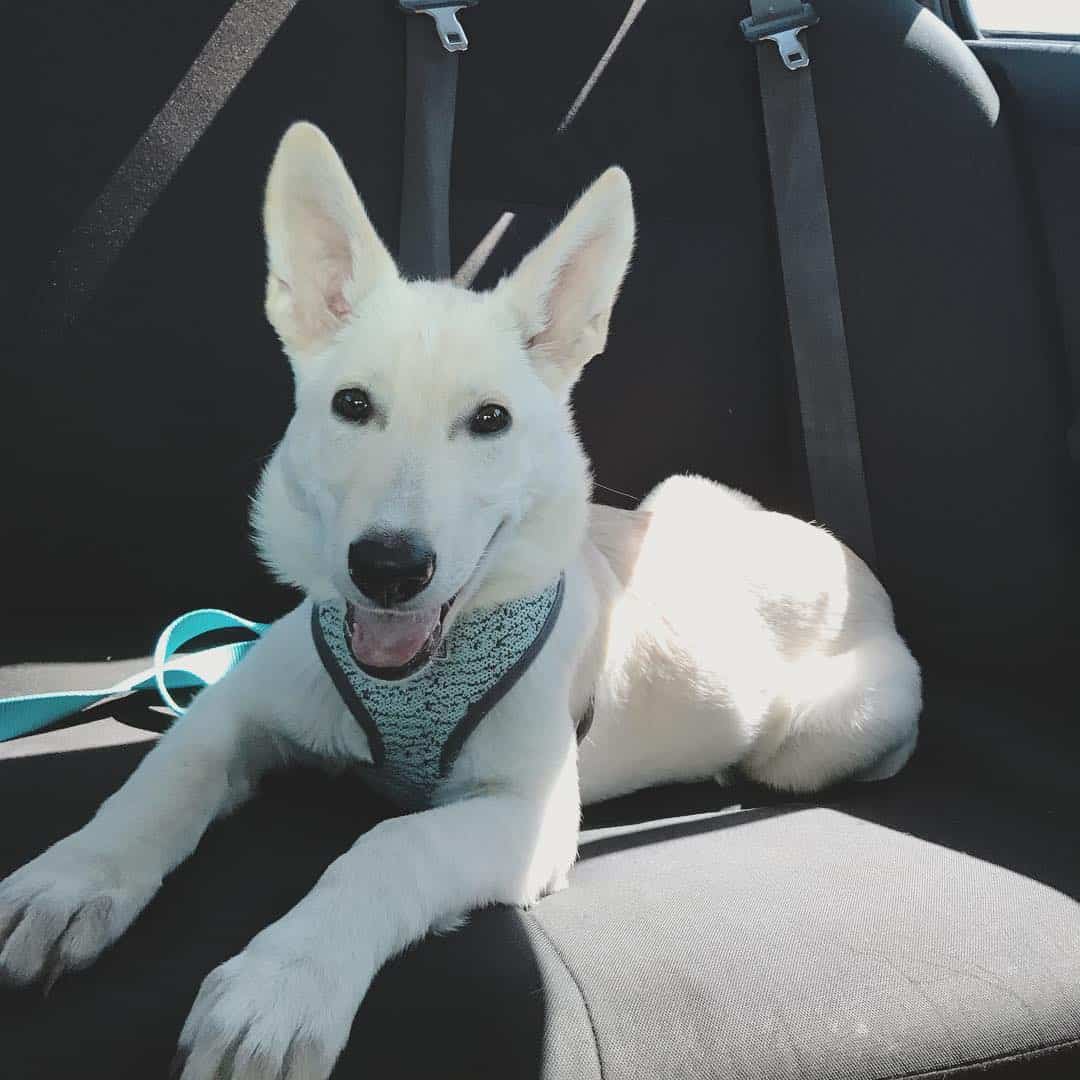
Photo from: @finandfallon
First, we have to mention one more time that a White German Shepherd is not an albino! They are white dogs with the normal characteristics of a GSD and a white coat color.
What is an Albino German Shepherd? An Albino German Shepherd lacks any kind of pigment, causing its skin and fur to become pristine white. The skin of an Albino German Shepherd is pink, as well as the nose leather and their eyes are a shade of pink too. The eyes can be blue sometimes, but if that happens the dog is called a partial albino.
So, if you see a white German Shepherd but it has a black nose and dark eyes — it is not an albino! It is a white type of GSD. Remember, Albino German Shepherd dogs have pink noses and pink eyes.
11. Isabella German Shepherd
The other name for this beautiful coat color is lilac. This type of German Shepherd is very rare and as such is very pricy, too. But what is an Isabella German Shepherd?
In essence, Isabella color is diluted Liver coat color. It has a royal origin and dogs are not the only animals that can have this beautiful coat color variation. Horses and birds are also lucky to have such beautiful colors. Why the name Isabella?
It comes from a story about a Spanish queen from the 15th century. Her name was Isabella Clara Eugenia, and she swore she wouldn’t change her dress until Spain conquered Granada. But the siege lasted longer than expected. She did keep her promise, but her dress changed color after such a long time. The color of her dress was the color we can see now in some dogs, horses, and birds.
12. Bi-color German Shepherd
This type of German Shepherd is a variation of a Black and Tan GSD. The main difference is actually quite obvious — the Bicolor German Shepherd has the majority of its body covered in black coat color. The paws, parts of the legs, under the tail, and sometimes eyebrows are other colors, usually tan.
Sometimes, this type can be mistaken for a darker Black and Tan German Shepherd, but in true Bi-color Shepherds, the tan or brown markings cover a small percentage compared to the black color. As a matter of fact, a true Bi-color German Shepherd has a very dark coat color and with just a few light brown or tan parts on its fur.
If you want to find out if your German Shepherd puppy is a Bi-colored or Black GSD, the best way, and the only true way to spot the difference is to look under the tail. If the puppy has a little bit of brown (of any shade) it is a Bi-color German Shepherd.
These dogs do not have any type of so-called saddle markings on the back. Also, besides brown, the lighter parts can be silver and sable, too.
13. Panda German Shepherd
Let’s just say right away that this German Shepherd has nothing to do with a Panda bear. They are not related, and Panda GSDs do not like bamboo. Jokes aside, the name Panda refers to the specific coat color variation that puts this German Shepherd in a completely different spot.
Panda German Shepherd is for GSDs what Piebald color is for some other dog breeds. For the German Shepherds, it refers to symmetrical bilateral black patches on the face with a white smudge going from the nose across the muzzle to the forehead.
The back is covered in a black saddle patch, but it can vary in size and shape from dog to dog. The main thing is that the lower parts of the body are white in color and turn to cream as you go up to the saddle part. It’s the same with the tail and chest.
The Panda German Shepherd is a Tri-colored dog in essence, with white, black, and tan color making various coat color patterns on the body. Although there are many variations of the patterns, they all have a “Panda” mask on the face, hence the name.
German Shepherd Origin
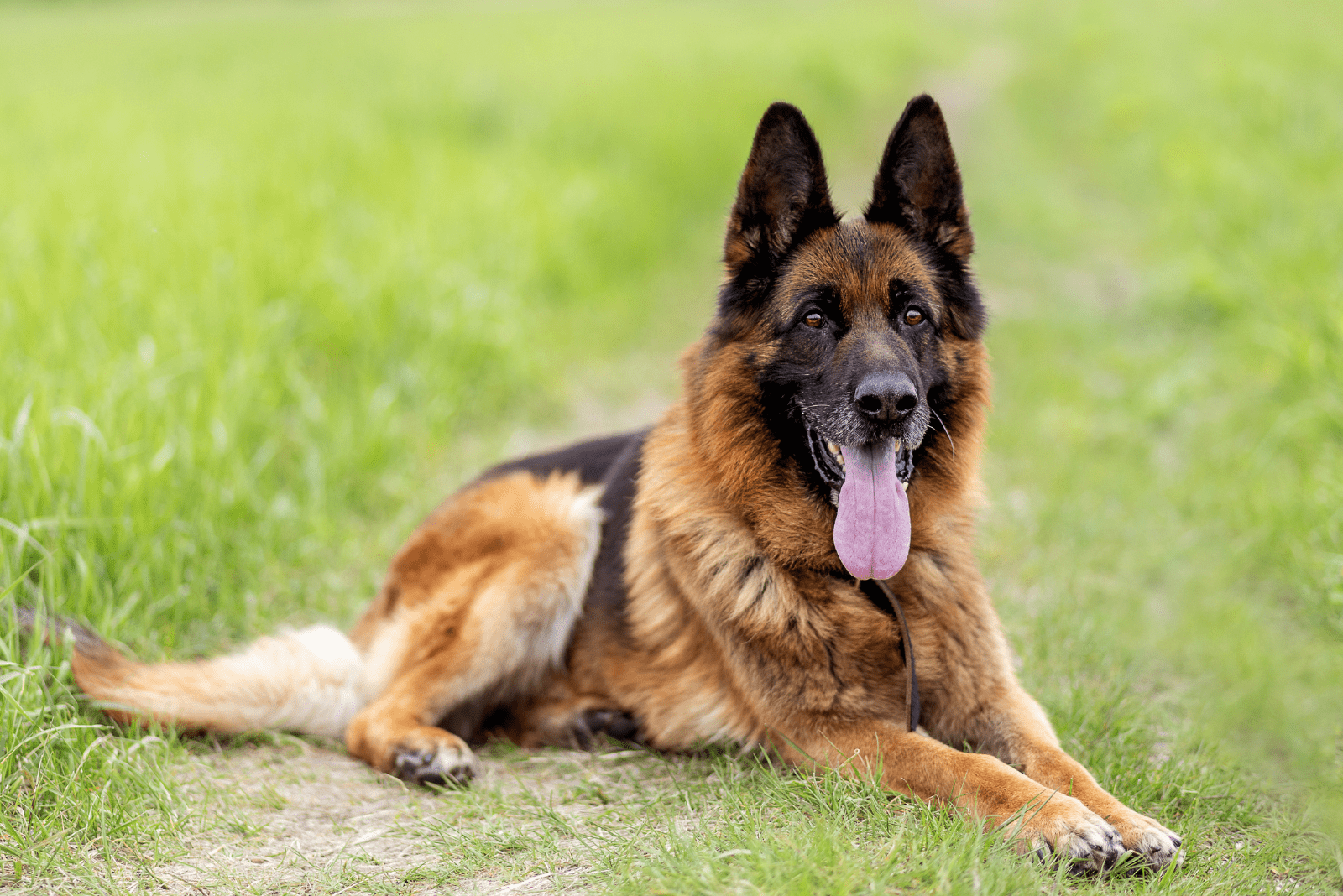
Der Deutsche Schäferhund — the original German name of the German Shepherd, dates back to the late 19th century. A German officer — Captain Max von Stephanitz, dedicated his life to perfecting and promoting this dog breed, and he is responsible for the amazing dog we have today. This dog was originally bred as a shepherd dog breed, hence the name.
But, since then, German Shepherd dogs have been used in more than just herding. They are used today as police dogs, service dogs, guard dogs, and military dogs. But, most importantly — they are one of the best family pets, too.
There is another name that comes up — Alsatian dog. This is the same dog as the German Shepherd. The reason behind this name comes from World War I and World War II when people did not want to call such an amazing dog a German dog. If you are wondering why — it is time to brush up on your history. Let’s just say that most of the world fought against the Germans in WWII, and because the times were sensitive, soldiers chose another name for this beautiful working dog.
But the German Shepherd does come from Germany and it has a hard work ethic. Don’t get fooled by its looks and work ethic because they can also be laid-back and the best dogs for any family.
German Shepherd General Appearance
This is a purebred dog recognized by the AKC (American Kennel Club). The German Shepherd is a large dog that can weigh up to 90 pounds and can grow up to 26 inches.
They have a double medium-length coat that can come in various coat color variations. It’s a well-muscled and agile dog, that gives out the appearance of a strong, calm, and brave dog.
They have erect ears, a long muzzle, and a long bushy tail. The gait is also very distinctive — the German Shepherd is a trotting dog, with an almost effortless gait, with a long reach. They are quite magnificent when you watch them, appearing like a wolf in the wilderness.
Is There a Health Difference Between German Shepherd Types?
There are no typical health differences between different types of GSD. They don’t have a lot of health problems connected directly to the breed in general either. All health issues they have are common to large dog breeds.
The health issues the German Shepherd can have are:
Both health issues can be prevented or early diagnosed if you take your dog for Hip and Elbow Evaluation tests. The severity of the problem can be reduced a lot if the vet starts the treatment of these health problems in the early stages.
Besides these health issues, a German Shepherd dog can suffer from bloating (GDV). This is a health issue common to all large dog breeds. Even though specific dog food has not been officially connected to bloating, you can stay on the safe side, by choosing the best dog food for your dog. That means food rich in proteins and vitamins and low in carbohydrates.
Other than that, the German Shepherd dog is a generally healthy dog breed.
The only GSD type that has specific health problems is the Albino German Shepherd. Because of the lack of pigment in their skin and hair cells, they are very sensitive to sunlight. The longer they are exposed to sunlight, the more serious the health issues that can happen. These problems can be eye related, too. Their eyes are not only sensitive to light, but they can be born with partial or total blindness.
If you want to keep your Albino German Shepherd safe, you should keep the coat as long as possible, use sunscreen cream as protection against the Ultraviolet rays whenever you go out with the dog, and use a doggy coat for extra protection. There are even special dog goggles to protect your dog’s eyes when you go out.
The Conclusion
We have been through the list of the 7 types of German Shepherds, and we have seen that there are 13 different coat color variations, but we can come to one conclusion: all German Shepherds are amazing dogs!
Whether you like the “original” Red and Black German Shepherd with physical traits of a West German Working Line or you like the unique Blue or Isabella GSD, they all share the same personality traits that made the German Shepherd dog such a famous dog breed all around the world.
They are all loyal, intelligent, brave, and family oriented.
No matter if you are looking for a companion dog, therapy dog, or you are looking for an amazing guard dog — a German Shepherd of any coat color, coat length, or body size is an excellent choice!
They will be your furry best friends showing unconditional love and affection, and it is only fair to show them love and take care of their health in return, too.
